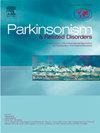帕金森病脑脊液神经炎症、突触功能障碍和[18F]多巴- pet的标志物
IF 3.4
3区 医学
Q2 CLINICAL NEUROLOGY
引用次数: 0
摘要
含有神经黑色素的细胞丢失、神经炎症和突触功能障碍被认为与帕金森病(PD)的发病机制有关。[18F]DOPA PET反映了壳核的多巴胺储存能力,而[18F]RO948的中脑脱靶保留率被假设反映了神经黑色素。目的探讨PD患者病程、脑脊液(CSF)神经退行性变标志物、突触功能障碍、神经炎症和多巴胺突触丢失([18F]DOPA PET测量)之间的关系。我们进一步探讨[18F]RO948中脑潴留减少是否与[18F]DOPA PET和CSF标志物有关。方法参与者是BioFINDER研究的一部分。对对照组(n = 623)、PD参与者(n = 226)和路易体痴呆(DLB; n = 33)的脑脊液生物标志物进行分析。[18F]对对照组(n = 514)、PD组(n = 77)和DLB组(n = 47)进行RO948 PET检查,[18F]对PD组(n = 58)和DLB组(n = 22)进行DOPA PET检查。结果spd患者脑脊液神经丝光(NfL)水平(pg/ml [mean±SD] 159±139)高于对照组(137±90,p < 0.001),神经颗粒蛋白水平(pg/ml [mean±SD] 620±255)低于对照组(772±283,p < 0.001)。较低的[18F]多巴摄取与较长的病程(ρ = - 0.46, p < 0.001)、较高的NfL (ρ = - 0.39, p = 0.03)、较低的神经颗粒蛋白(ρ = 0.50, p = 0.003)和NPTX2水平(ρ = 0.36, p = 0.049)相关。我们发现神经炎症标志物与[18F]DOPA PET之间没有关联。PD组黑质[18F]RO948信号([mean±SD] 1.67±0.22)低于对照组(1.76±0.3,p < 0.001),但与病程、脑脊液标志物或[18F]DOPA-PET无关。结论PD患者[18F]DOPA PET滞留减少与病程、脑脊液神经退行性和突触生物标志物相关,但与炎症生物标志物或[18F]RO948 PET中脑脱靶滞留无关。本文章由计算机程序翻译,如有差异,请以英文原文为准。
CSF markers of neuroinflammation, synaptic dysfunction and [18F]DOPA-PET in Parkinson's disease
Introduction
Neuromelanin containing cell loss, neuroinflammation and synaptic dysfunction are believed to contribute to Parkinson's disease (PD) pathogenesis. [18F]DOPA PET reflects dopamine storage capacity in the putamen, while midbrain off-target retention of [18F]RO948 is hypothesized to reflect neuromelanin.
Objectives
To investigate associations between disease duration, cerebrospinal fluid (CSF) markers of neurodegeneration, synaptic dysfunction, neuroinflammation, and dopamine synaptic loss as measured by [18F]DOPA PET in PD patients. We further aimed to explore whether reduced midbrain retention of [18F]RO948 relates to [18F]DOPA PET and CSF markers.
Methods
Participants were part of the BioFINDER studies. CSF biomarkers were analyzed for controls (n = 623), PD participants (n = 226) and Dementia with Lewy bodies (DLB; n = 33). [18F]RO948 PET was performed in controls (n = 514), PD (n = 77) and DLB (n = 47) and [18F]DOPA PET in PD (n = 58) and DLB (n = 22).
Results
PD patients showed higher CSF neurofilament light (NfL) levels (pg/ml [mean ± SD] 159 ± 139) vs. controls (137 ± 90, p < 0.001), and lower neurogranin (pg/ml [mean ± SD] 620 ± 255) vs (772 ± 283, p < 0.001). Lower [18F]DOPA uptake correlated with longer disease duration (ρ = −0.46, p < 0.001), higher NfL (ρ = −0.39, p = 0.03), lower neurogranin (ρ = 0.50, p = 0.003) and NPTX2 levels (ρ = 0.36, p = 0.049). We found no associations between neuroinflammatory markers and [18F]DOPA PET. Substantia nigra [18F]RO948 signal was lower in PD ([mean ± SD] 1.67 ± 0.22) vs controls (1.76 ± 0.3, p < 0.001) but did not correlate with disease duration, CSF markers or [18F]DOPA-PET.
Conclusions
In PD patients, a decrease in [18F]DOPA PET retention correlated with disease duration as well as CSF neurodegenerative and synaptic biomarkers but not with inflammatory biomarkers or [18F]RO948 PET midbrain off-target retention.
求助全文
通过发布文献求助,成功后即可免费获取论文全文。
去求助
来源期刊

Parkinsonism & related disorders
医学-临床神经学
CiteScore
6.20
自引率
4.90%
发文量
292
审稿时长
39 days
期刊介绍:
Parkinsonism & Related Disorders publishes the results of basic and clinical research contributing to the understanding, diagnosis and treatment of all neurodegenerative syndromes in which Parkinsonism, Essential Tremor or related movement disorders may be a feature. Regular features will include: Review Articles, Point of View articles, Full-length Articles, Short Communications, Case Reports and Letter to the Editor.
 求助内容:
求助内容: 应助结果提醒方式:
应助结果提醒方式:


